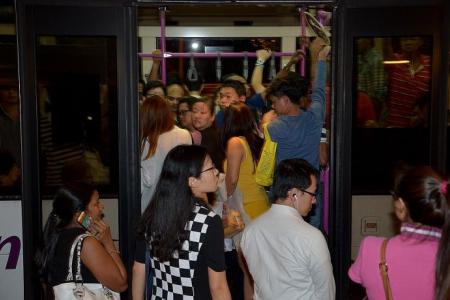MRT chaos: Man walks from Orchard to Bishan to get home
Bus stop too crowded so one commuter walks from Orchard to Bishan
He walked almost 80 minutes from the crowded bus stop outside Royal Plaza on Scotts back to his home in Bishan on Tuesday evening.
Mr Leroy Lee, 26, was waiting for a bus home after dinner with his friends at Orchard Road, but gave up after waiting for half an hour.
He could not get on any bus because they were all fully packed.
A power fault caused a 3½-hour disruption to train services on SMRT's North-South and East-West Lines on Tuesday evening, the first time train services on both lines had broken down at the same time.
Passengers were stranded at bus stops, trying to catch free buses home.
"There were so many people queueing at the bus stop and some were standing on the pavement," said Mr Lee.
Instead of taking a taxi, he decided to make the long walk home and stuck to it all the way.
"I just took it as exercise," said the programmer, who walked from Scotts Road to Newton Road, Thomson Road, Marymount Road, Jalan Pemimpin and finally to Bishan Road.
Miss Ain Zainal, 23, took 30 minutes instead of her usual 10 minutes by train to get home from work on Tuesday.
She had been waiting to break fast when she was caught in the train disruption. Her train stopped at Aljunied MRT Station, one stop from her home near Kallang station.
"The train lights went off and the doors were open," said the marketing and communications executive.
After train operators announced that services had stopped, she got off the train to take a bus at the station. But it was so crowded that she missed four buses.
"There was no free shuttle bus and no signs were put up. There were people giving out fliers with directions printed on it.
"I'm just so tired of this. I just wanted to go home and eat," said Miss Ain, adding that it was the third time she had been caught in a major train disruption.
A student, Miss K. Y. Song, 19, was heading home from dinner at Clementi on Tuesday night.
She took a bus from Clementi Station to MacRitchie Reservoir, hoping to switch to another bus to her home in Sembawang Close.
But the bus stop at MacRitchie was crowded and some buses arrived fully packed, she said.
Miss Song waited for about 40 minutes, then walked to an eatery at Upper Thomson Road, where she stayed for about 45 minutes before taking a Uber car home.
"I did not need to pay extra charges for my Uber ride, which was quite a nice perk," she said.
Miss Reshmi R. Nair, 30, took almost an hour to get from her workplace in Bukit Gombak to her home in Lakeside.
"The train journey usually takes me 10 minutes. But the trains were very slow on Tuesday night.
"The train doors couldn't close for 10 minutes at Bukit Gombak. The train also kept stopping in between Jurong East and Lakeside station," said the operations manager.
While the train breakdown left many commuters frustrated and red-faced, some were smiling because of it.
Madam Azlina Mohd, 45, who works at malaykueh.com, a shop at Toa Payoh Bus Interchange, said that her food was sold out.
Many of her customers were Muslims, who were breaking fast.
"Usually, there will be a bit of leftover food when we close, but on Tuesday, we sold out," she told The New Paper.
Kusina Filipino, a Filipino food store at Jurong East bus interchange, saw sales increase by 10 per cent.
Said the stall's boss, Mrs Maria Koh, who has been running the business for more than two years: "Business was better because some people might have been hungry and thirsty from waiting for the free buses.
"We closed a bit later on Tuesday night as people kept buying my drinks."
She added that the bus interchange had been very crowded but orderly.
A worker at Shan Dong Da Bao, which sells buns at Jurong East bus interchange, said that business was slightly better.
"I guess those who didn't have dinner bought a bun from us. Some people also asked us for bus directions," said the worker, who wanted to be known only as Madam Liu.
"It was a bit messy at about 8pm, but by 9pm there were long, orderly queues.
"There were a lot of people, but the free buses came very quickly," said Madam Liu, a Chinese national who has been working here for more than a month.
There were so many people queueing at the bus stop and some were standing on the pavement.
- Mr Leroy Lee
Commuters say Uber tried to exploit situation
First, commuters left stranded by the MRT disruptions on Tuesday had complained of having to pay up to five times the normal price of a Uber ride.
In response, the private taxi company explained its dynamic pricing, which places multipliers on fares when demand for its taxis are higher than the number of Uber taxis on the road.
A spokesman said it turned off the feature when it realised people were stranded because of the MRT breakdown.
Despite this, some commuters claimed that before Uber turned off the feature, it had sent out alerts encouraging drivers to make more money out of the disruptions.
A reader told The New Paper that the company sent out text messages to its drivers telling them the disruptions were a good opportunity to make money.
Some of the text messages told drivers that they could "earn $$$ taking people home from MRT stations!", the reader added.
UNAWARE
Responding to queries, a spokesman for Uber told TNP yesterday that they were aware of the messages sent.
"The messages were meant to provide incentive for the drivers to get more of them on the road so that passengers had more means to get to the locations they wanted," the spokesman added.
"There was no intention to take advantage of the situation to earn more money."
Commuters can use Uber by registering on their mobile app. Registered users can request for Uber taxis via the app and are informed of estimated fares and surges before it is confirmed. Not all commuters were upset with the company though.
Mr Kenny Koh, 30, praised the service. The IT engineer said: "They were really efficient and transparent with their prices. It was my first time using (Uber) and it won't be my last."
SMRT 'not 100% sure' of root cause of breakdown
Train services on the East-West and North-South Lines recovered yesterday morning after a major breakdown on Tuesday evening.
They were crippled because a safety device was triggered, causing power supply to trains to be cut off, said SMRT's managing director of trains Lee Ling Wee.
Commuters had to look for alternative transport options until train services resumed 3½ hours later.
Tuesday's incident is the first time train services on both lines broke down at the same time.
It also marks the worst disruption for SMRT since Dec 15, 2011, when train services were down for about six hours on the North-South Line between Bishan and Marina Bay, affecting about 127,000 commuters.
Two days later, train service on the North-South Line was disrupted between Toa Payoh and Marina Bay, affecting about 94,000 commuters.
SMRT, however, is still not "100 per cent sure" of the root cause of Tuesday's breakdown.
Mr Lee narrowed it down to three possible causes, which he shared at a joint press conference with the Land Transport Authority (LTA) yesterday.
TRACK
The power cables that connect to the third rail could have been damaged, causing a power trip that triggered the safety device. The third rail is a conductor that runs alongside the entire track and provides electricity to each train.
POWER SUBSTATION
Something faulty at the power substation, where power runs through cables to the third rail.
TRAIN
Something broken dangling from the train that touched the third rail, causing the power to trip. SMRT has since ruled out this cause after checking all the trains on Tuesday night.
On the same night, three faults were also found and rectified, Mr Lee added. The faults were:
- The insulation of two power cables along the North-South line was damaged.
- A faulty relay system (an electrical device activated by a current or signal in one electric circuit to open or close another circuit) was found at Kranji's power substation.
- There was water leakage along a section of the Tanjong Pagar tunnel, close to a third rail insulator.
Train services resumed without a glitch after these faults were rectified, but it is not clear if they had a "system-wide effect" on the rail network, said SMRT chief executive Desmond Kuek.
The faults found in SMRT's investigations were not identified during routine maintenance checks, which are conducted every six months or yearly, Mr Lee conceded.
He said that in an ageing system, some of the train parts may fail in between the interval checks.
The train operator is looking at monitoring devices that can identify faults on a real-time basis, Mr Lee added. It is also considering stepping up the frequency of checks.
LTA's chief executive Chew Men Leong added that a new voltage-limiting device has been piloted for Downtown Line 1, which can contain power trips into smaller zones.
Mr Lee said it will take some time for SMRT and LTA to look through all the data becoming coming up with a solution.
Mr Chew also promised to leave no stone unturned in this investigation.
Am very concerned at the major disruption to train services last night... We are still trying to find out the cause of the problem. LTA and SMRT staff and engineers worked through the night checking trains, tracks and cables. Today fortunately trains ran without a glitch, so far. But because we have not identified the root cause of the power trips, we are still very worried that the problem may recur. Hope we identify and resolve the faults quickly, to prevent further inconvenience to commuters.
- Prime Minister Lee Hsien Loong, in a Facebook post
Get The New Paper on your phone with the free TNP app. Download from the Apple App Store or Google Play Store now





